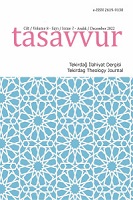İlimler Tasnifi ve Tarihi Açısından Taşköprülüzâde’ye Göre Fıkıh ve Fıkıh Usûlü İlimleri
Fiqh and Usūl Al-Fiqh According to Tashkoprīzāda in Terms of Classification and History of Sciences
Author(s): Sümeyye ONUK DEMİRCİSubject(s): Religion and science , History of Islam, Contemporary Islamic Thought, Sociology of Religion, Qur’anic studies
Published by: Tekirdağ Namık Kemal Üniversitesi İlahiyat Fakültesi
Keywords: Fiqh; Uṣūl al-fiqh; the Classification of Sciences; Tashkoprīzāda; Miftāhu’s-sa‘āda;
Summary/Abstract: Islamic scholars, who encountered works on the classification of sciences together with their translation activities, formed their own classification traditions by classifying the sciences from different perspective. These classifica tions, which position the sciences by considering the connection between reason and revelation, and pointing to the hierarchy and relationship between the sciences, also reflect the understanding of science on which they are based. In this context, we can talk about two different classification traditions put forward by Islamic philosophers on the one hand and Islamic scholars on the other. At this point, Tashkoprīzāda (d. 958/1561), one of the 16th century Ottoman scholars, created an original classification of sciences that influenced the future by benefiting from both traditions. Tashkoprīzāda, who sees the classification of sciences as a branch of science at the same time, has written four valuable books in this field, especially his book called Miftāhu’s-sa‘āda. These works contain rich information about the history of sciences as well as the classification of sciences. He determined the sciences of fiqh and usūl alfiqh as a sub-branch of shar‘īsciences and gave both historical and current information about these sciences by focusing on the works of influential scholars. Tashkoprīzāda, who is followed Hanafi sect and saw the Hanafi school as the most virtuous one, handled the fiqh section by putting the Hanafi school in the center. One of the remarkable points is that Tashkoprīzāda completed the part in which he dealt with the historical process of Hanafi fiqh with two great scholars, such as MewlānāCalāleddīn al-Konewī (v. 672/1273) and Sheikh Badraddin as-Simāwī(v. 823/1420), who stood out with their Sufism. It is also important in terms of showing the mystic environment in which Tashkoprīzāda was influenced and his approach to the relationship between tasawwuf and fiqh. Another point that makes Tashkoprīzāda’s works stand out in terms of the history of sciences is that he mentions famous and acceptable works by referring to the curriculum of his period and surroundings. Thus, Tashkoprīzāda reveals the classification of sciences as a whole with its history, hierarchy and curriculum.
Journal: Tasavvur Tekirdağ İlahiyat Dergisi
- Issue Year: 8/2022
- Issue No: 2
- Page Range: 879-913
- Page Count: 35
- Language: Turkish

